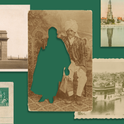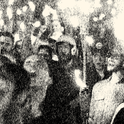Just what is it that motivates young western women to sign up for jihad? The role of those who travel to Iraq and Syria with a view to joining Islamic State (IS), the jihadist group that now controls a territory larger than the United Kingdom, is a current source of fascination for the western media. Why would girls who have grown up in liberal, democratic states willingly sign up to a group that decapitates, crucifies and immolates those it perceives to be its enemies—what can be drawing them in?
Many of these Western female jihadists, who refer to themselves as muhaajirat—literally, immigrants—are very prominent on social media, be it Twitter, Facebook or Tumblr. There are at least 50 who have built a profile in this manner. They post incessantly, seemingly addicted to the limelight and attention. The internet helps them share the details of their new lives in the so-called Caliphate, adding to the adventurism and utopianism that permeates all of IS’s recruitment propaganda. They tweet about weapons training and policing, implying that they fill leading positions in IS all-female brigades and units, stressing the great excitement of it all.
The reality, though, may not resemble that which is peddled by these girls who are, as much as anything, seeking to acquire more of a following, get more attention. Indeed, often, the claims that English-speaking female jihadists make on social media do not really square up to the extreme austerity of IS’ jihadism. For example, this week, photos were circulated on Twitter showing four girls—fully veiled—holding guns. The caption below read “fun day training for self defence in the Islamic State with humble sisters.” This was much more likely to be a recruitment stunt than a true example of what life in the IS caliphate is truly like.
This hypothesis, widely agreed upon by analysts but with few primary resources to back it up, is greatly supported in a document that I have been translating over the last fortnight.
Running just shy of 10,000 words, it first appeared on Al Platform Media, an internet forum used almost exclusively by IS jihadists, on 23rd January 2015. Entitled "Women in the Islamic State: Manifesto and Treatise", the document was penned by an individual (or individuals) who claimed that they were part of the media wing of Al-Khanssaa Brigade, an all-female policing organisation operating in IS territory. Just like the blog of the 20-year-old Glaswegian girl, Aqsa Mahmood, which offered step-by-step advice on how to marry an IS fighter, this document is IS propaganda.
What was interesting was its content, which was markedly different to that which British female jihadists peddle. There was none of the sense of adventure circulated by British female jihadists. Absent, too, was the feeling of excitement. Women, according to this, are created “of Adam, and for Adam.” Their role is uneventful, repetitive; “there is no responsibility greater for her than that of being a wife to her husband.”
Women, it is unambiguously stated, are equally as important as men in God’s eyes. However, in terms of the roles they play, there are myriad—“divine”—limitations set in place that stop them from playing anything other than a supporting role as a mother and wife. According to the document, the age at which women can be married off is as young as nine years old. It is not for a woman to pick up an AK-47, nor is it her role to defend IS from the frontlines. Rather, what is far more important is that they “remain hidden and veiled, maintaining society from behind this veil.”
Throughout the document, which is no longer accessible online, probably removed because it openly promoted terrorist actions, there is a strong message to convey—that men and women are just as important as each other, but the former get to move around, work, socialise and fight, and the latter do not. Women have been appointed the qualities of “sedentariness, stillness and stability” and men, “their opposites: movement and flux.”
If nothing else, this manifesto, the first such document of its kind, provides the reader with insight into an IS jihadist’s idealised conception of what its version of womanhood is. The fact that it was not translated by IS is significant—it is indicative of the fact that jihadist propaganda is not a one-size-fits-all tool. Clearly, what appeals to a jihadist woman in the Arabian Peninsula is not the same as what appeals to one in the West. Different messages resonate with different people, and IS is all too aware of that.
Sisters in arms: why women fight for Islamic State
A document has emerged detailing the repressive rules governing women's lives
February 06, 2015

Female Islamic State fighters












